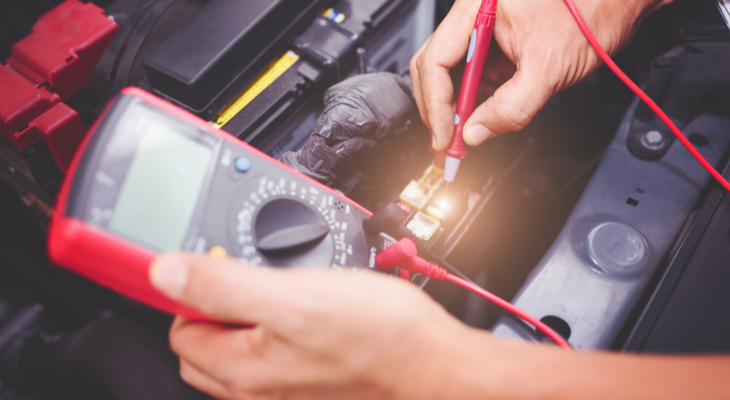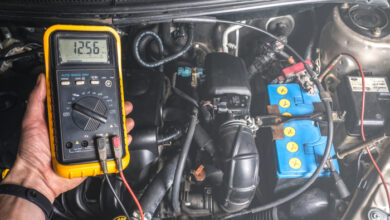How to Test a Car Battery Guide

A dead battery is a motorist’s worst nightmare. Hearing nothing but silence when you start your car is definitely not the best way for you to start your journey.
If you have been driving for a while, then chances are this has happened to you a couple of times.
Although there are many reasons why your car may not start such as leaving the headlights on all night, it’s only through testing that you can conclude whether to jumpstart or replace your battery.
With a multimeter, you can tell if your battery is dead or it simply needs to be recharged.
In this article, we are going to take you through a step by step guide on how to test your car battery to see if it needs to be charged or changed out.
What Is A Car Battery For?
To fully understand why you should test your car battery regularly, allow us to catch you up to speed on what is its purpose in your vehicle. As you all know, a car battery is a mandatory component of an automobile.
It stores electrical energy and provides the power needed to start your car. Other than that, it also keeps your engine running throughout your journey and leaves behind enough charge to start your car next time you turn it on.
Additionally, a car battery also transfers energy to an alternator which converts direct current to electric current that enables the performance of key functions in your car like the audio system, wipers, and headlights.
As you can see a dead battery won’t only disable these key functions but will leave you stranded.
When Do You Need To Test It and Tools Needed
According to most manufacturers, a battery should be tested at least twice per year. One of the main factors that cause battery wear is hot and cold weather.
A hot climate can lead to rapid evaporation of the acid inside it lowering the amount of power it can produce. Cold weather, on the other hand, slows the chemical reaction in the battery, lowering its voltage and forcing it to work harder to start your car.
Those residing in areas that have low temperatures are advised to test their batteries in late Fall and Spring so as to get accurate readings. You should also ensure your car is parked in a heated space to prevent the battery from freezing.
There are some warning signs that could indicate it is time for you to test your car battery. And they include;
- The battery signal being illuminated on your car dashboard
- Engine cranking slowly when starting
- Jumpstarting your vehicle regularly
- Headlights that appear dimmer
- A clicking sound being produced when starting your car
- The car being unable to start
All the above could signal a dead car battery. You should always be alert when driving your car and note down any warning signs early in advance.
The good thing about testing a car battery is that the only tool you need is a multimeter and an extra person to help you out. This cheap and simple tool can help you determine if your battery is healthy enough to keep around or its time to replace it.
Kindly note that a multimeter can only be used on maintenance-free batteries, their counterpart, maintainable batteries can be tested using a hydrometer.
How to Test It?
As mentioned above, a multimeter can only be used to test a maintenance-free battery. And before you start, ensure that the battery has not been used for at least an hour.
If you happen to test it immediately after switching your engine off, the results will be altered by a charge from the electrical system of your car.
For those planning to test their cars in the morning, don’t hook it up overnight.
Having confirmed all the following, you can test your battery.
- Prepare your multimeter by setting it to voltage and adjusting it to 20 DC volts.
- Signal your assistant to turn on the headlights. This will activate the battery and get rid of surface discharge.
- Turn the lights off.
- Respectively press the positive and negative probes to the battery terminals. Identifying the positive and negative will be easy because both are color-coded; the positive terminal and probe are red whereas the negative terminal and probe are black.
- Check and note down the readings.
- Start the car and take the final reading.
- Compare your results with the following recommended values.
Before making any comparison, you should know the outside temperature affects the voltage. A fully charged battery should measure 12.66 volts and above.
At a temperature of 30 degrees, the reading should be 12.5 volts whereas a temperature of 80 degrees should record a voltage of 12.6. A battery that is three-quarters charged should give a reading of 12.45 volts.
Any readings below 12 volts are a clear indication of a discharged battery. Results ranging from 12.3 to 12.5 volts, you can redo the test after fully charging the battery.
After starting your car, you should get a voltage above 10. If it drops below 5 volts when the car is running, then your battery needs immediate replacement.
Bottom Line
Although most manufacturers’ warranty their batteries to last for 3 to 4 years, it’s only a few that make it to this point.
If you can’t remember the last time you replaced your battery and it starts misbehaving, a battery test can give you clarity on the way forward.



